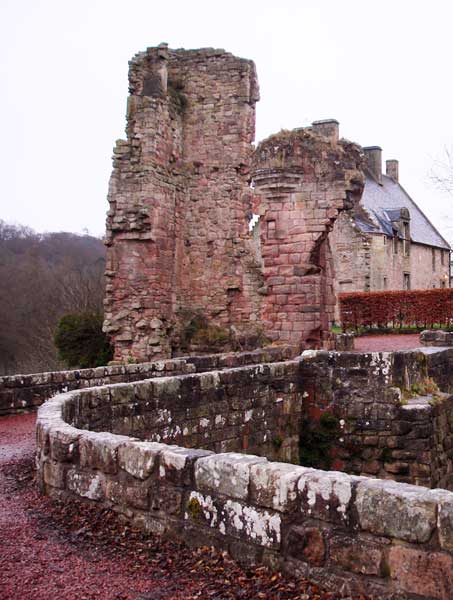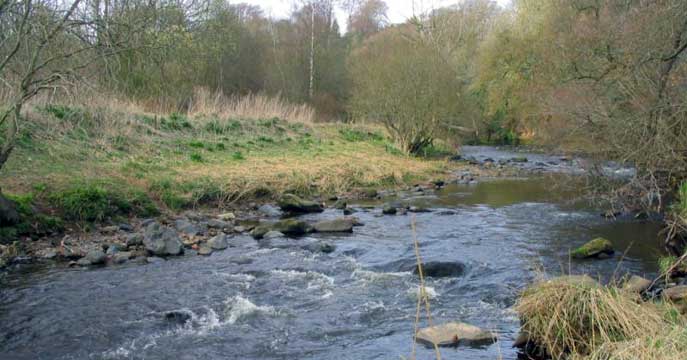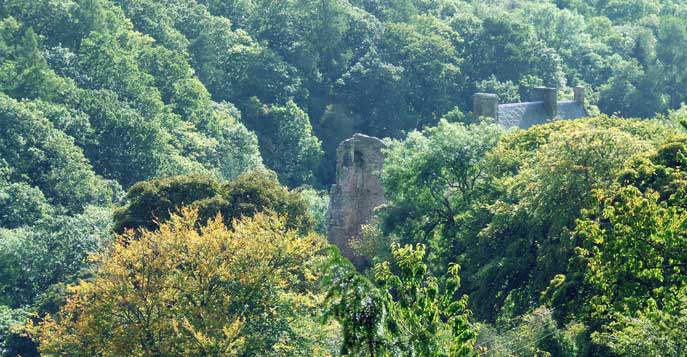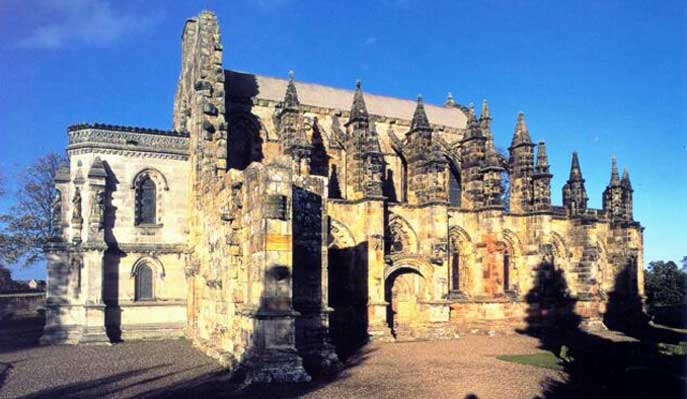THE BATTLE OF ROSSLYN 1303 |
 |
In the thirteenth century Scotland although an independent country, suffered from a feudal system that crippled its economy, reducing the country to a series of warring states due not only to Clan battles for land and wealth in the North, but continual oppression by the English in the Lowlands. Scotland, was divided into the Highlands north of Perth, and the Lowlands from Perth to the border, mostly garrisoned by the English army or Scottish lords who had been forced to give their allegiance to Edward the first, the English King. After the tragic death of King Alexander at Kinghorn, Edward the first, always cast an avaricious eye towards Scotland, his chance came after the demise of the little Maid of Norway. No fewer than thirteen noble claimants to the crown of the northern kingdom had come forward; the land was threatened by vicious civil war. The Lords of Scotland appealed to Edward that he might graciously arbitrate, he accepted, with gilded crown and chain in hand; the Lion would now adjudicate the Unicorn Edward as regal bearer of this self-sought Scottish manacle was more than willing to apply it; he demanded that on the 10th of May 1291, at his castle at Norham, the Lords of the north attend him. For the purpose of a hearing of the primary claimants, now reduced to eight. The long adjudication began, the Scottish people had desired a King with nothing but Celtic blood and one of undivided loyalty, this was declared the issue of Edward's mandate to arbitrate Weeks passed, and the finalists were reduced to the families of Balliol and Bruce. |
The Scots Lords now painfully aware of their feet on alien soil and foreign king deciding the fate of their crown silently watched as the two remaining claimants in turn swore to abide by Edwards's decision as their liege and sovereign Lord of the land. Edwards's final favour fell upon his dependent John Balliol. With this choice the Unicorn was finally chained and the die cast for a suicidal war of escape from England's strangling chains. The smile on the teeth of the Lion was warm for his new Scottish subjects as John Balliol was crowned the puppet king at Scone on November the 30th, 1292. Dutifully, Balliol appeared later to do homage to Edward at Newcastle bearing with him the ancient seal of Scotland. Shock however, attended the faces of his faithful followers as Edward took the old and regal seal in his hands and broke it into four pieces and ordered that they be placed in the English treasury as a token of his English dominion. This act gave Edward the first the legal right to Scotland under Norman Law. However, Scotland's law even then, differed from English law, in that it was the people in the form of the Scottish parliament that made the law in Scotland and not just the King. Edward had always been aware that in order to rule and hold Scotland that he had to give lands in England to the Scottish nobles and effect marital unions between the daughters of Scottish noble families to his Norman English Lords, this was not acceptable to the Scottish nobility. When a marriage was arranged between Balliol's son and the Count of Anjou's daughter, one of Edward's French enemies. Edward was so infuriated that he sent an English force into Scotland in 1296. Berwick was the first town in Scotland, Edward hung over 10,000 of its inhabitants from their own doorframes to show what he was capable of, giving a clear message to all that might oppose his will. His army then moved to Dunbar to defeat a Scottish army and capture most of its leaders, which included Sir William St.Clair of Rosslyn, Sir Symon Fraser of Neidpath, Sir Gilbert Hay of Borthwick, and Sir Edward Ramsay of Dalhousie. Edward made the captured Scottish nobles swear Fealty and allegiance to the English crown before they were released, this they did with tongue in cheek, and were allowed to return to their lands. King John Balliol or Toom Tabard as he became known was forced to abdicate. Scotland was left without a king. Sir John Seagrave, who was Edward's governor General to the ``Province'' of Scotland, was also the English commander of Edinburgh castle. He had more than a passing interest in Lady Margaret Ramsay of Dalhousie and was a frequent visitor to the Ramsay castle, but the Lady Margaret's favour was the young Henry St.Clair of Rosslyn. This obviously caused a problem for Seagrave. . |
 |
| In the turbulent year of 1297, the young Henry St.Clair was elevated to the rank of Knight by Sir Symon Fraser, many Scottish lords were present at the ceremony including William Wallace, Guardian of Scotland, Lady Margaret Ramsay was appointed Queen of the day as part of the ceremony for the new Knight. During the proceedings news reached Rosslyn, that an English army was marching on Stirling, Wallace called a war council of those present, then set off for Stirling with young Sir Henry St.Clair at his side. The two armies met on the 13th of September, greatly outnumbered and ill-equipped, the Scots under Wallace's tactical brilliance achieved a great victory, Sir Henry St. Clair in command of the Scots cavalry played his part well, taking out the archers and routing the English force. When late in the year 1302, Sir John Seagrave received the information that Sir Henry St. Clair was about to marry Lady Margaret Ramsay, he became incensed and sent a letter from his base in Carlisle to Edward asking for his permission to invade Scotland, this was expediently granted, and in the middle of February 1303, an English force of 30,000 men crossed the border into Scotland under the cover of darkness, avoiding the warning beacons being lit on the border hills, they succeeded in reaching Melrose. Where Seagrave split the force into three equal parts, in order to attack three different targets. Sir Robert Neville was to attack Borthwick Castle, Sir Ralph Confrey's force was designated Dalhousie castle, while the remaining force under Sir John Seagrave, and assisted by the English paymaster Ralph de Manton marched on Rosslyn. The English invading forces had managed to get fairly close to their objectives, before news reached Prior Abernethy of Mount Lothian who dispatched riders to alert important leaders such as Sir William Wallace near Paisley, Sir John Comyn near Glasgow, Sir Symon Fraser of Neidpath, Somerfield of Carnwath, Simon of the Lee, The Flemming of Cumbernauld and the Knights of the Hospital at Torphicen urging them to muster at Biggar with all speed. Prior Abernethy, who was the Cistercian prior of Mount Lothian, the western outpost or gate of Balentradoch, the Templar headquarters in Scotland. Abernethy may have been a Templar knight before becoming a Cistercian Prior. By the afternoon of the 23rd of February 1303 some 8,000 Scots had rallied to the call of arms. Overall command of the Scottish forces was offered to Sir William Wallace, but was declined by him because of his earlier defeat at the battle of Falkirk in 1298 when the battle was lost due to the abandonment by many Scottish nobles and their forces believing that Wallace had designs on the vacant Scottish throne. The battle of Falkirk was the epitome of Scotland at this time, jealousy and divisionism ruled. Wallace had lost many close friends and allies at Falkirk; his reaction was to give up his title of Guardian of Scotland. Sir Symon Fraser was appointed supreme commander of the Scottish forces, on Wallace's recommendation. All knights involved confirmed this. The Scottish forces moved from Biggar to Carlops some ten miles north, where the monks faithful to Prior Abernethy fed the troops, after the Prior had conducted Mass. Abernethy whose knowledge of the terrain was second to none being his ecclesiastical see, guided the troops during the night of the 23rd/24th of February across the difficult terrain to the area of the valley of the north Esk river between Penicuick and the village of Roslin. |
 |
Three thousand troops under the command of Sir John Comyn went into hiding in the woods on the west bank of the river Esk. The remaining five thousand crossed the river and circled to the southeast commanded by Sir Symon Fraser but, guided by the knowledgeable Prior. They formed a large crescent battle formation behind the English encampment of Sir John Seagrave on the high ground east of the river. Gradually tightening the crescent as they crept stealthily forward on the sleeping encampment the early morning was dark and cloudy so the Scots soldiers were able to contain the element of surprise, without being challenged until the very last moment the Scots fell upon the sleeping English soldiers, with such ferocity that many were killed in their sleep. In the confusion of the attack some soldiers tried to escape into the forest towards the southwest, the flat area or haugh below the present castle only to be confronted by the second force that had lay in ambush. The English losses were so great and so sudden that Seagrove soon realised that further resistance would result in total annihilation of his soldiers and he surrendered himself and the survivors of his mangled force to Sir William Wallace and pleaded for quarter, the remaining English soldiers followed their commanders orders and lay down its weapons. They had sustained severe casualties many of the wounded died before the dawn broke. This was how the first phase of the battle was won by the Scots at very little cost to themselves in the form of fatalities or wounded. The few Scots that were wounded were tended to by the women of the Sinclairs of Rosslyn in the grounds of the castle, which was where the present chapel now stands. The castle also provided a hasty meal, before the victorious soldiers took up their second battle positions to the northwest of Roslin. On the advice of Sir William Wallace they formed a line of battle on the summit of the Langhill. They did not have long to wait; the second English force under the command of Ralph de Confrey was seen to approach from the direction of the Ramsay's castle of Dalhousie where they had abandoned their siege. Having virtually no knowledge of the area or terrain, the English army charged up the Langhill to be met by volleys of arrows from the Scottish archers, which broke the charge and threw the English force into total confusion, resulting in the charging English soldiers wheeling towards the north, not realising that they were heading towards a steep ravine with a stream at its foot. Because of the force of the weight of their own troops in retreat, it caused a juggernaut effect. Most of the force plunged down the ravine to their deaths. The Scots pikes and archers drove them like sheep to their deaths. Others continued to fall or be pushed over the precipice on top of the troops and horses that had already fallen, resulting in the burn being choked with dead and dying soldiers. Heavy cavalry horses, soldiers with weapons and equipment became a deadly entangled mass. Ralph de Confrey the commander of the force died with his men at the bottom of the ravine. The carnage was so terrible that very few survived this overwhelming defeat. The Scots hearing of the approach of the third section of the English force killed most of their English captives from the second encounter to stop them joining the third force. Chivalry was abandoned in favour of expediency. The Scots then moved northeast along the river Esk, and positioned themselves near the top of a steep bank overlooking the River Esk, close by the village of Polton. The Scots soldiers by now exhausted by their Herculean efforts. Having marched all throughout the night with little food or rest having fought in two fierce conflicts, and although the elation of victory was great, they were almost on the point of collapse. |
 |
| Abernethy had been aware of the possibility of such an eventuality. In the morning before the second engagement he had sent a small party of his Cistercian brothers to erect a huge St Andrews cross, made of wood and canvas on the highest point on the Pentland hills. Being February the sun was low in the sky and set behind the hill illuminating the cross on the hill, giving it the appearance of a fiery cross. The Prior gave the exhausted Scots soldiers an inspiring oration, reminding them of Edward and England's persecution of Scotland, talking of the massacre of Berwick and the desecration of Scone Abbey and the history of the Scots nation. As soon as he observed the cross was in place he instructed the Scots army to turn towards the Pentlands pointing out the cross saying that it was a sign from the Lord of Hosts that they were fighting under the banner of heaven. They knelt in prayer, the prior giving them benediction and absolving them from their sins. This so inspired the Scots troops that the fatigue fell from them and they approached the next battle, refreshed if not physically certainly spiritually. The English third group under the command of Sir Robert Neville had come from Borthwick castle near Catcune in the valley of Gorebridge, by way of Rosewell marching along the river valley. Again the Scots army made use of the physical geography. The third part of the English army made its way to Roslin unaware of the destruction of Ralph de Confreys force. They travelled along the cart-road, which followed the glen. The Scots had positioned themselves at Mountmarle which looked down on the road to the west and right of the English force, to the east and left of the English soldiers were the steep cliffs of the Glen dropping down vertically some one hundred feet to the river Esk. The Scottish archers again created havoc and panic in the English ranks from the high ground, again the Scottish troops charged down from the high ground panicking the English troops and driving them before them over the precipitous cliffs to their deaths. Thousands were killed without ever being able to strike a blow; many were killed who never managed to unsheathe their swords. So incredible was the carnage meted out to the English force that Sir Symon Fraser, the Scottish Commander called on his troops to give quarter and allowed the survivors of decimated force to escape with their lives. So total was the victory it was later stated that only ten per cent of the entire English force ever made it back to the safe haven of English soil. Sir John Seagrave and Ralph de Manton, the English paymaster and other captured knights who survived were ransomed. Soldiers who were captured were released without their weapons and allowed to return south of the border after they had sworn an oath never again to take up arms against Scotland. So ended one of the greatest battles of the wars of Scottish independence, which without doubt had a significant effect on the Scots at that time, never before had such a small Scots Army triumphed over an English army of such numbers, the odds were almost four to one in the English favour. The Scots had used their local knowledge of the physical geographical landscape of Roslin Glen and the surrounding area as the main weapon in their armoury, that combined with the tenacity and courage of the Scots soldiers had won the day. It is not a battle that is well known in Scottish history; due principally to the fact that the Comyns had taken part in the battle and the Bruce had not. It is always interesting to note that history is written by the winner, and it is possible that in recording Scotland's wars of independence, the battle of Roslin was emitted. However as if by divine right, we still have to this day in Roslin, names like the Killburn at the foot of Langhill brae, the Hewin near Mountmarle, Stinking rigg, and Shinbanes field, a name which derived from when it was being ploughed in the nineteenth century, five cartloads of bones were dug up and reburied. In a direct line east to west, running from Mountmarle to Carnethy hill (a corruption of Abernethy) we come across the village of Glencourse or its earlier name Glencross a reference no doubt, to the cross built by the clever Priors monks. Only in retrospect can the battle of Roslin be placed in its rightful place in the history of Scotland's struggle for independence, and the confidence that it gave this small but defiant Nation to retain the goal of travelling along its own god given path to its own destiny, secured on Bannockburn field. |
The Sons Of Scotland would like to thank THE CLAN SINCLAIR for all their help with this History lesson. |
 |
© Paisley Tartan Army 2008-09
